Organisational Structure, Culture, and Government Impact on NHS
VerifiedAdded on 2020/11/23
|10
|3132
|476
Report
AI Summary
This report provides an in-depth analysis of the organizational structure of the National Health Service (NHS), a public sector healthcare provider. It examines various organizational structures, including functional, matrix, centralized, decentralized, and flat structures, and identifies the matrix structure as the one primarily utilized by the NHS. The report also delves into the structure and culture of the NHS, highlighting its commitment to high-quality patient care. Furthermore, it explores different organizational cultures applicable to the public sector, such as power, role, and task cultures, emphasizing the NHS's adoption of a task culture. The report also discusses the impact and role of central and local government in public services, including budget allocation and spending reviews. Finally, it assesses the roles, structure, and culture of government and monitoring organizations, concluding with a comprehensive overview of the NHS's operational framework.
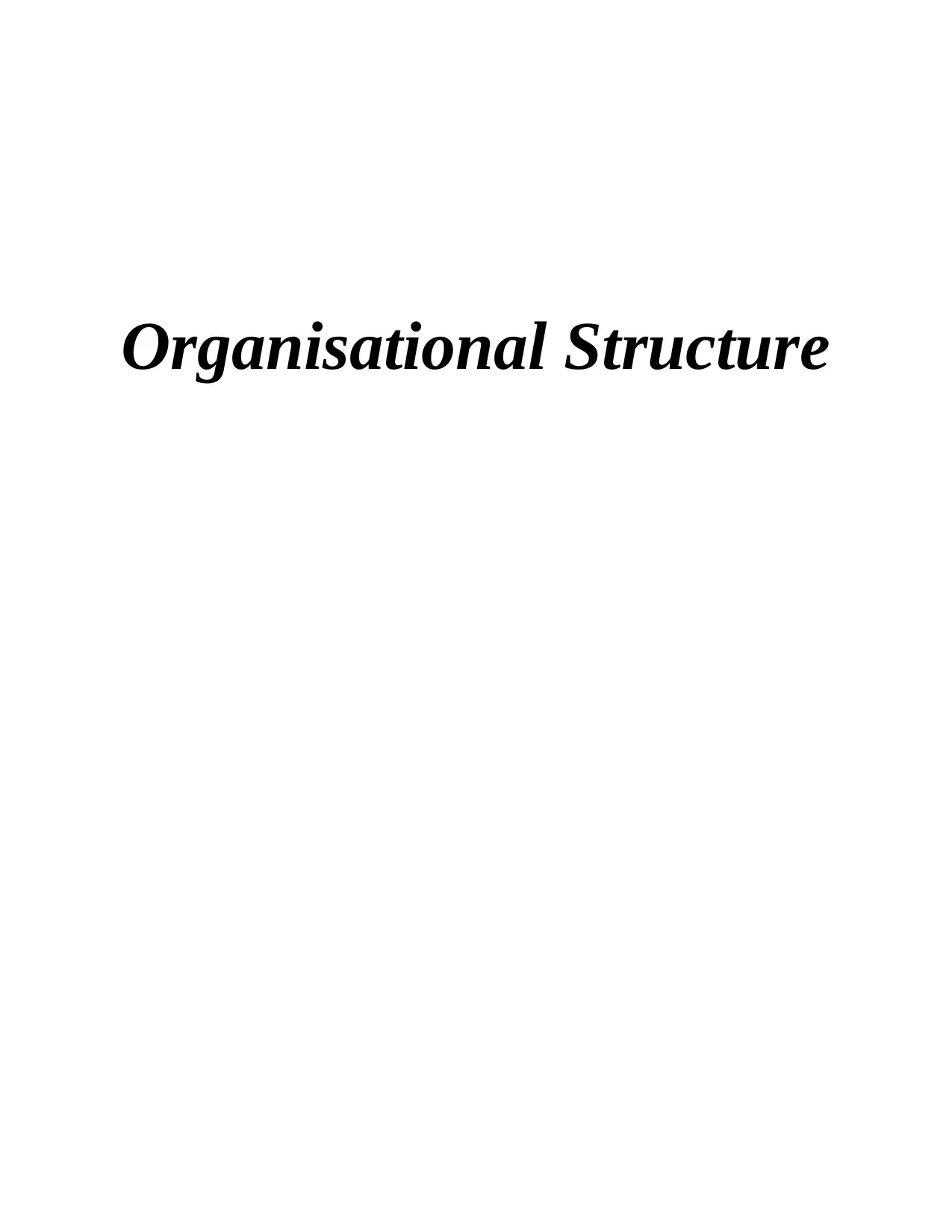
Organisational Structure
Paraphrase This Document
Need a fresh take? Get an instant paraphrase of this document with our AI Paraphraser
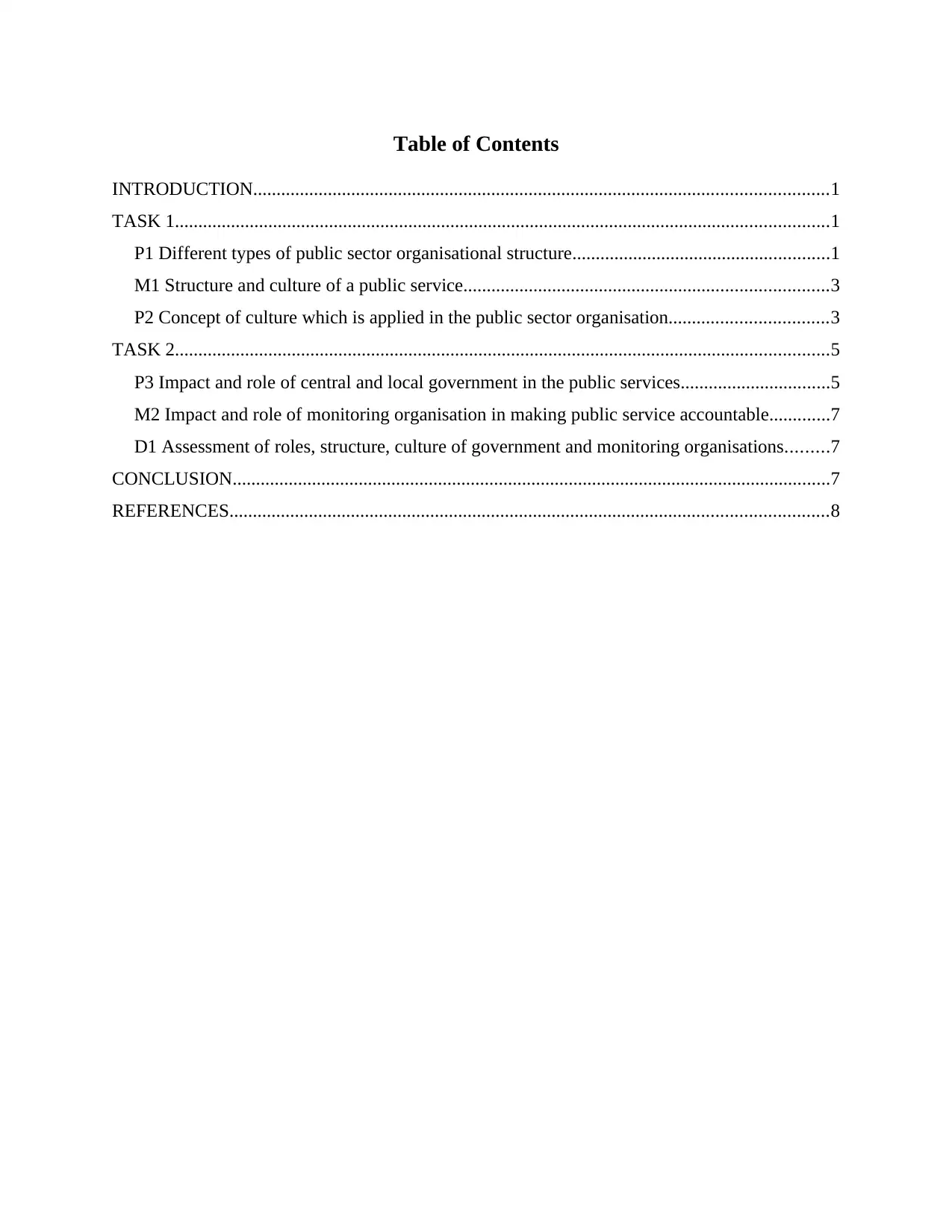
Table of Contents
INTRODUCTION...........................................................................................................................1
TASK 1............................................................................................................................................1
P1 Different types of public sector organisational structure.......................................................1
M1 Structure and culture of a public service..............................................................................3
P2 Concept of culture which is applied in the public sector organisation..................................3
TASK 2............................................................................................................................................5
P3 Impact and role of central and local government in the public services................................5
M2 Impact and role of monitoring organisation in making public service accountable.............7
D1 Assessment of roles, structure, culture of government and monitoring organisations.........7
CONCLUSION................................................................................................................................7
REFERENCES................................................................................................................................8
INTRODUCTION...........................................................................................................................1
TASK 1............................................................................................................................................1
P1 Different types of public sector organisational structure.......................................................1
M1 Structure and culture of a public service..............................................................................3
P2 Concept of culture which is applied in the public sector organisation..................................3
TASK 2............................................................................................................................................5
P3 Impact and role of central and local government in the public services................................5
M2 Impact and role of monitoring organisation in making public service accountable.............7
D1 Assessment of roles, structure, culture of government and monitoring organisations.........7
CONCLUSION................................................................................................................................7
REFERENCES................................................................................................................................8
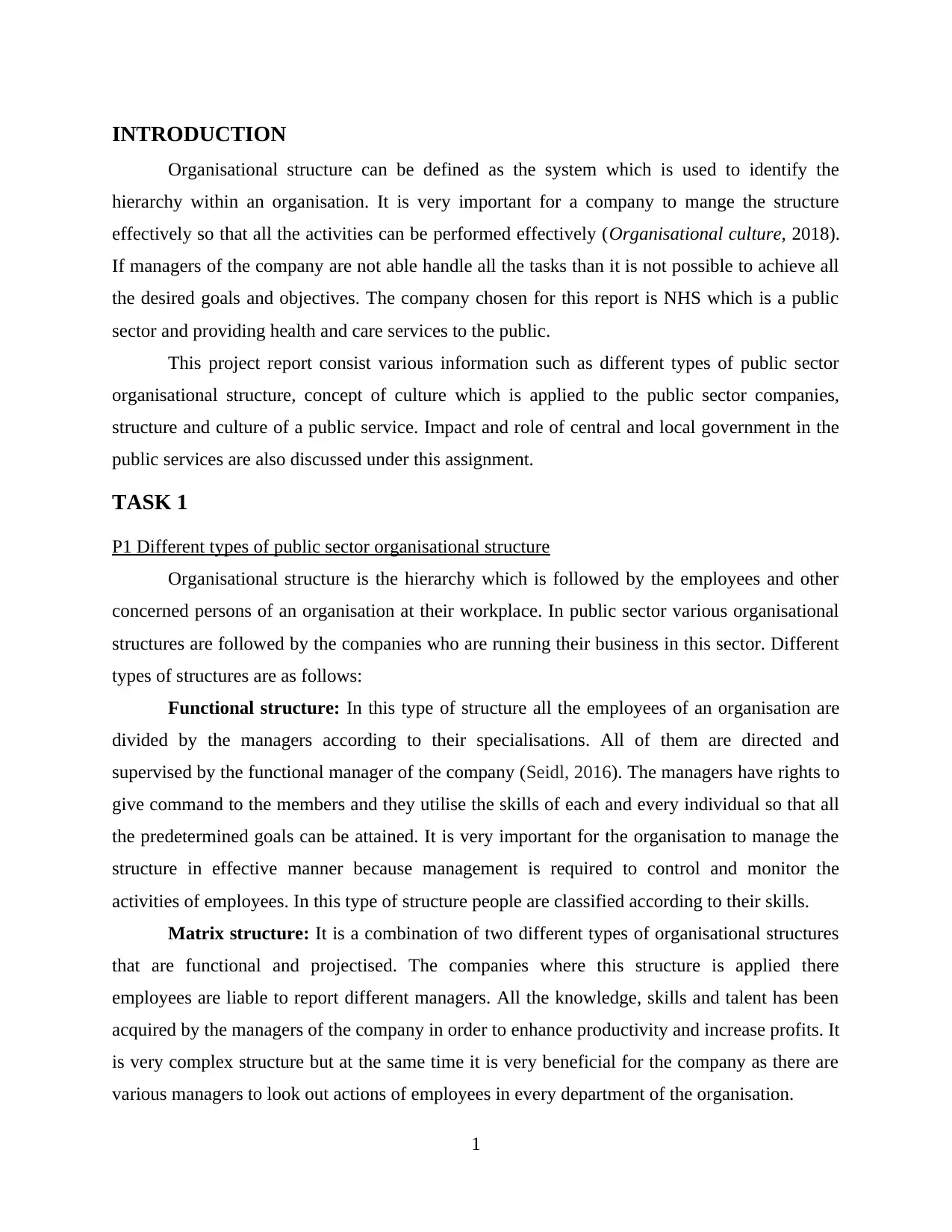
INTRODUCTION
Organisational structure can be defined as the system which is used to identify the
hierarchy within an organisation. It is very important for a company to mange the structure
effectively so that all the activities can be performed effectively (Organisational culture, 2018).
If managers of the company are not able handle all the tasks than it is not possible to achieve all
the desired goals and objectives. The company chosen for this report is NHS which is a public
sector and providing health and care services to the public.
This project report consist various information such as different types of public sector
organisational structure, concept of culture which is applied to the public sector companies,
structure and culture of a public service. Impact and role of central and local government in the
public services are also discussed under this assignment.
TASK 1
P1 Different types of public sector organisational structure
Organisational structure is the hierarchy which is followed by the employees and other
concerned persons of an organisation at their workplace. In public sector various organisational
structures are followed by the companies who are running their business in this sector. Different
types of structures are as follows:
Functional structure: In this type of structure all the employees of an organisation are
divided by the managers according to their specialisations. All of them are directed and
supervised by the functional manager of the company (Seidl, 2016). The managers have rights to
give command to the members and they utilise the skills of each and every individual so that all
the predetermined goals can be attained. It is very important for the organisation to manage the
structure in effective manner because management is required to control and monitor the
activities of employees. In this type of structure people are classified according to their skills.
Matrix structure: It is a combination of two different types of organisational structures
that are functional and projectised. The companies where this structure is applied there
employees are liable to report different managers. All the knowledge, skills and talent has been
acquired by the managers of the company in order to enhance productivity and increase profits. It
is very complex structure but at the same time it is very beneficial for the company as there are
various managers to look out actions of employees in every department of the organisation.
1
Organisational structure can be defined as the system which is used to identify the
hierarchy within an organisation. It is very important for a company to mange the structure
effectively so that all the activities can be performed effectively (Organisational culture, 2018).
If managers of the company are not able handle all the tasks than it is not possible to achieve all
the desired goals and objectives. The company chosen for this report is NHS which is a public
sector and providing health and care services to the public.
This project report consist various information such as different types of public sector
organisational structure, concept of culture which is applied to the public sector companies,
structure and culture of a public service. Impact and role of central and local government in the
public services are also discussed under this assignment.
TASK 1
P1 Different types of public sector organisational structure
Organisational structure is the hierarchy which is followed by the employees and other
concerned persons of an organisation at their workplace. In public sector various organisational
structures are followed by the companies who are running their business in this sector. Different
types of structures are as follows:
Functional structure: In this type of structure all the employees of an organisation are
divided by the managers according to their specialisations. All of them are directed and
supervised by the functional manager of the company (Seidl, 2016). The managers have rights to
give command to the members and they utilise the skills of each and every individual so that all
the predetermined goals can be attained. It is very important for the organisation to manage the
structure in effective manner because management is required to control and monitor the
activities of employees. In this type of structure people are classified according to their skills.
Matrix structure: It is a combination of two different types of organisational structures
that are functional and projectised. The companies where this structure is applied there
employees are liable to report different managers. All the knowledge, skills and talent has been
acquired by the managers of the company in order to enhance productivity and increase profits. It
is very complex structure but at the same time it is very beneficial for the company as there are
various managers to look out actions of employees in every department of the organisation.
1
⊘ This is a preview!⊘
Do you want full access?
Subscribe today to unlock all pages.

Trusted by 1+ million students worldwide
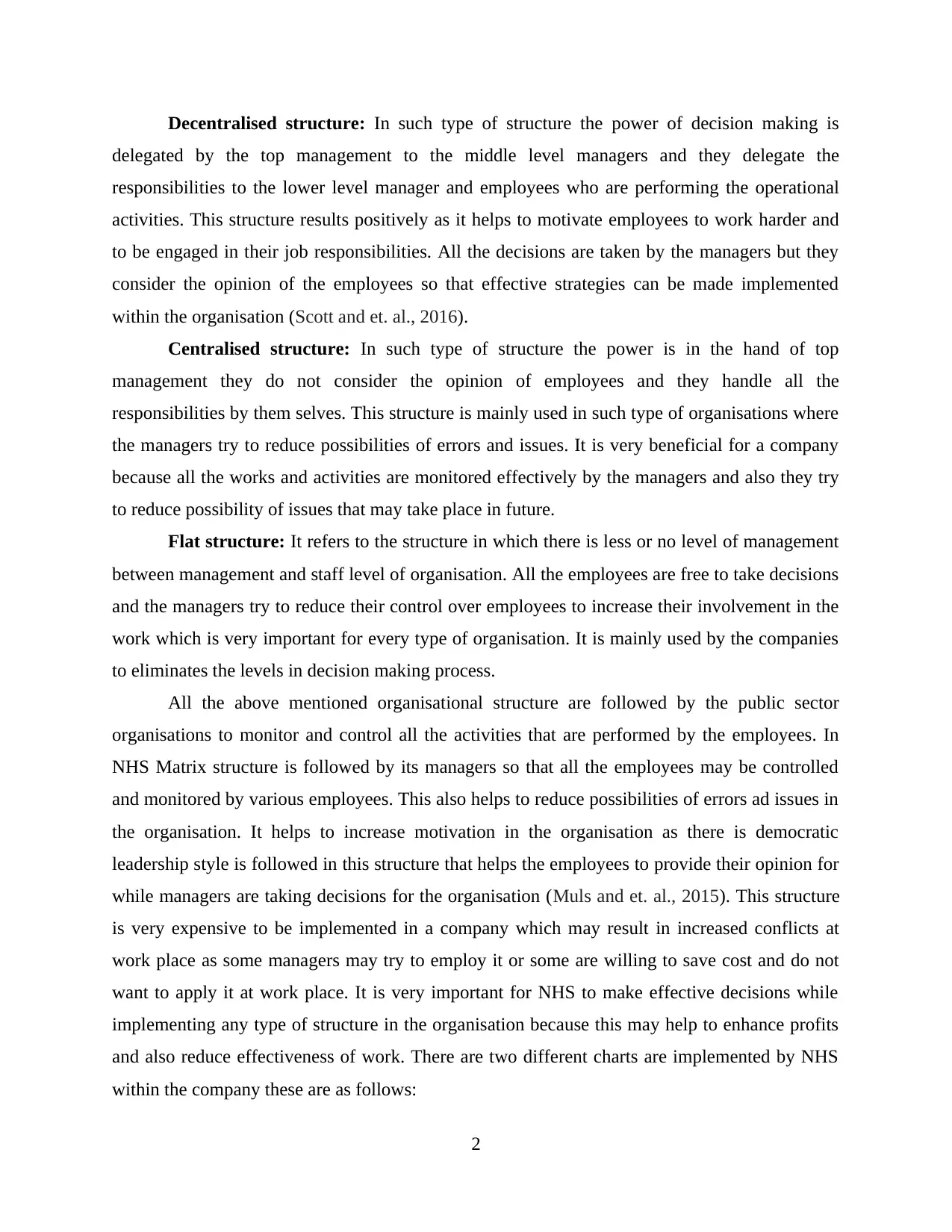
Decentralised structure: In such type of structure the power of decision making is
delegated by the top management to the middle level managers and they delegate the
responsibilities to the lower level manager and employees who are performing the operational
activities. This structure results positively as it helps to motivate employees to work harder and
to be engaged in their job responsibilities. All the decisions are taken by the managers but they
consider the opinion of the employees so that effective strategies can be made implemented
within the organisation (Scott and et. al., 2016).
Centralised structure: In such type of structure the power is in the hand of top
management they do not consider the opinion of employees and they handle all the
responsibilities by them selves. This structure is mainly used in such type of organisations where
the managers try to reduce possibilities of errors and issues. It is very beneficial for a company
because all the works and activities are monitored effectively by the managers and also they try
to reduce possibility of issues that may take place in future.
Flat structure: It refers to the structure in which there is less or no level of management
between management and staff level of organisation. All the employees are free to take decisions
and the managers try to reduce their control over employees to increase their involvement in the
work which is very important for every type of organisation. It is mainly used by the companies
to eliminates the levels in decision making process.
All the above mentioned organisational structure are followed by the public sector
organisations to monitor and control all the activities that are performed by the employees. In
NHS Matrix structure is followed by its managers so that all the employees may be controlled
and monitored by various employees. This also helps to reduce possibilities of errors ad issues in
the organisation. It helps to increase motivation in the organisation as there is democratic
leadership style is followed in this structure that helps the employees to provide their opinion for
while managers are taking decisions for the organisation (Muls and et. al., 2015). This structure
is very expensive to be implemented in a company which may result in increased conflicts at
work place as some managers may try to employ it or some are willing to save cost and do not
want to apply it at work place. It is very important for NHS to make effective decisions while
implementing any type of structure in the organisation because this may help to enhance profits
and also reduce effectiveness of work. There are two different charts are implemented by NHS
within the company these are as follows:
2
delegated by the top management to the middle level managers and they delegate the
responsibilities to the lower level manager and employees who are performing the operational
activities. This structure results positively as it helps to motivate employees to work harder and
to be engaged in their job responsibilities. All the decisions are taken by the managers but they
consider the opinion of the employees so that effective strategies can be made implemented
within the organisation (Scott and et. al., 2016).
Centralised structure: In such type of structure the power is in the hand of top
management they do not consider the opinion of employees and they handle all the
responsibilities by them selves. This structure is mainly used in such type of organisations where
the managers try to reduce possibilities of errors and issues. It is very beneficial for a company
because all the works and activities are monitored effectively by the managers and also they try
to reduce possibility of issues that may take place in future.
Flat structure: It refers to the structure in which there is less or no level of management
between management and staff level of organisation. All the employees are free to take decisions
and the managers try to reduce their control over employees to increase their involvement in the
work which is very important for every type of organisation. It is mainly used by the companies
to eliminates the levels in decision making process.
All the above mentioned organisational structure are followed by the public sector
organisations to monitor and control all the activities that are performed by the employees. In
NHS Matrix structure is followed by its managers so that all the employees may be controlled
and monitored by various employees. This also helps to reduce possibilities of errors ad issues in
the organisation. It helps to increase motivation in the organisation as there is democratic
leadership style is followed in this structure that helps the employees to provide their opinion for
while managers are taking decisions for the organisation (Muls and et. al., 2015). This structure
is very expensive to be implemented in a company which may result in increased conflicts at
work place as some managers may try to employ it or some are willing to save cost and do not
want to apply it at work place. It is very important for NHS to make effective decisions while
implementing any type of structure in the organisation because this may help to enhance profits
and also reduce effectiveness of work. There are two different charts are implemented by NHS
within the company these are as follows:
2
Paraphrase This Document
Need a fresh take? Get an instant paraphrase of this document with our AI Paraphraser
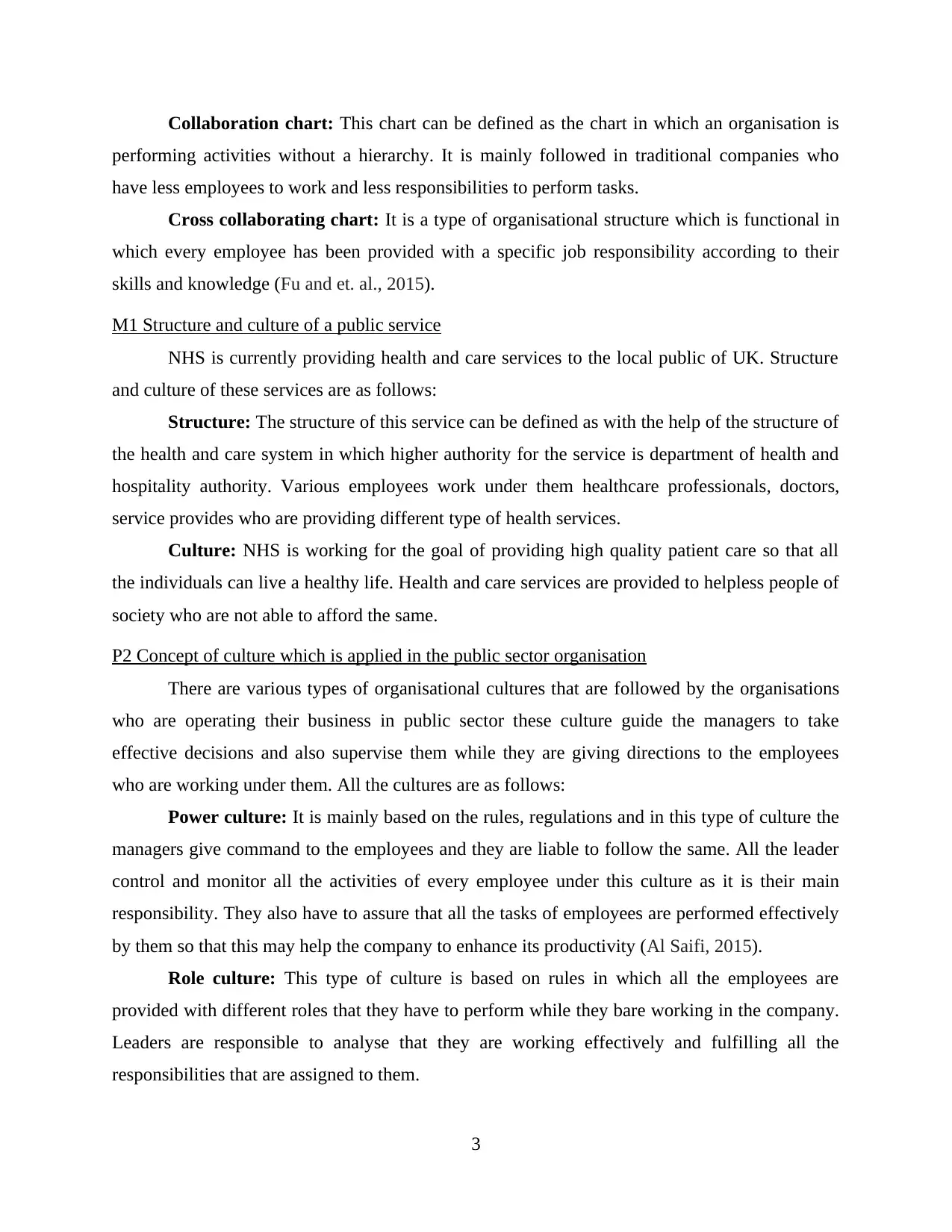
Collaboration chart: This chart can be defined as the chart in which an organisation is
performing activities without a hierarchy. It is mainly followed in traditional companies who
have less employees to work and less responsibilities to perform tasks.
Cross collaborating chart: It is a type of organisational structure which is functional in
which every employee has been provided with a specific job responsibility according to their
skills and knowledge (Fu and et. al., 2015).
M1 Structure and culture of a public service
NHS is currently providing health and care services to the local public of UK. Structure
and culture of these services are as follows:
Structure: The structure of this service can be defined as with the help of the structure of
the health and care system in which higher authority for the service is department of health and
hospitality authority. Various employees work under them healthcare professionals, doctors,
service provides who are providing different type of health services.
Culture: NHS is working for the goal of providing high quality patient care so that all
the individuals can live a healthy life. Health and care services are provided to helpless people of
society who are not able to afford the same.
P2 Concept of culture which is applied in the public sector organisation
There are various types of organisational cultures that are followed by the organisations
who are operating their business in public sector these culture guide the managers to take
effective decisions and also supervise them while they are giving directions to the employees
who are working under them. All the cultures are as follows:
Power culture: It is mainly based on the rules, regulations and in this type of culture the
managers give command to the employees and they are liable to follow the same. All the leader
control and monitor all the activities of every employee under this culture as it is their main
responsibility. They also have to assure that all the tasks of employees are performed effectively
by them so that this may help the company to enhance its productivity (Al Saifi, 2015).
Role culture: This type of culture is based on rules in which all the employees are
provided with different roles that they have to perform while they bare working in the company.
Leaders are responsible to analyse that they are working effectively and fulfilling all the
responsibilities that are assigned to them.
3
performing activities without a hierarchy. It is mainly followed in traditional companies who
have less employees to work and less responsibilities to perform tasks.
Cross collaborating chart: It is a type of organisational structure which is functional in
which every employee has been provided with a specific job responsibility according to their
skills and knowledge (Fu and et. al., 2015).
M1 Structure and culture of a public service
NHS is currently providing health and care services to the local public of UK. Structure
and culture of these services are as follows:
Structure: The structure of this service can be defined as with the help of the structure of
the health and care system in which higher authority for the service is department of health and
hospitality authority. Various employees work under them healthcare professionals, doctors,
service provides who are providing different type of health services.
Culture: NHS is working for the goal of providing high quality patient care so that all
the individuals can live a healthy life. Health and care services are provided to helpless people of
society who are not able to afford the same.
P2 Concept of culture which is applied in the public sector organisation
There are various types of organisational cultures that are followed by the organisations
who are operating their business in public sector these culture guide the managers to take
effective decisions and also supervise them while they are giving directions to the employees
who are working under them. All the cultures are as follows:
Power culture: It is mainly based on the rules, regulations and in this type of culture the
managers give command to the employees and they are liable to follow the same. All the leader
control and monitor all the activities of every employee under this culture as it is their main
responsibility. They also have to assure that all the tasks of employees are performed effectively
by them so that this may help the company to enhance its productivity (Al Saifi, 2015).
Role culture: This type of culture is based on rules in which all the employees are
provided with different roles that they have to perform while they bare working in the company.
Leaders are responsible to analyse that they are working effectively and fulfilling all the
responsibilities that are assigned to them.
3
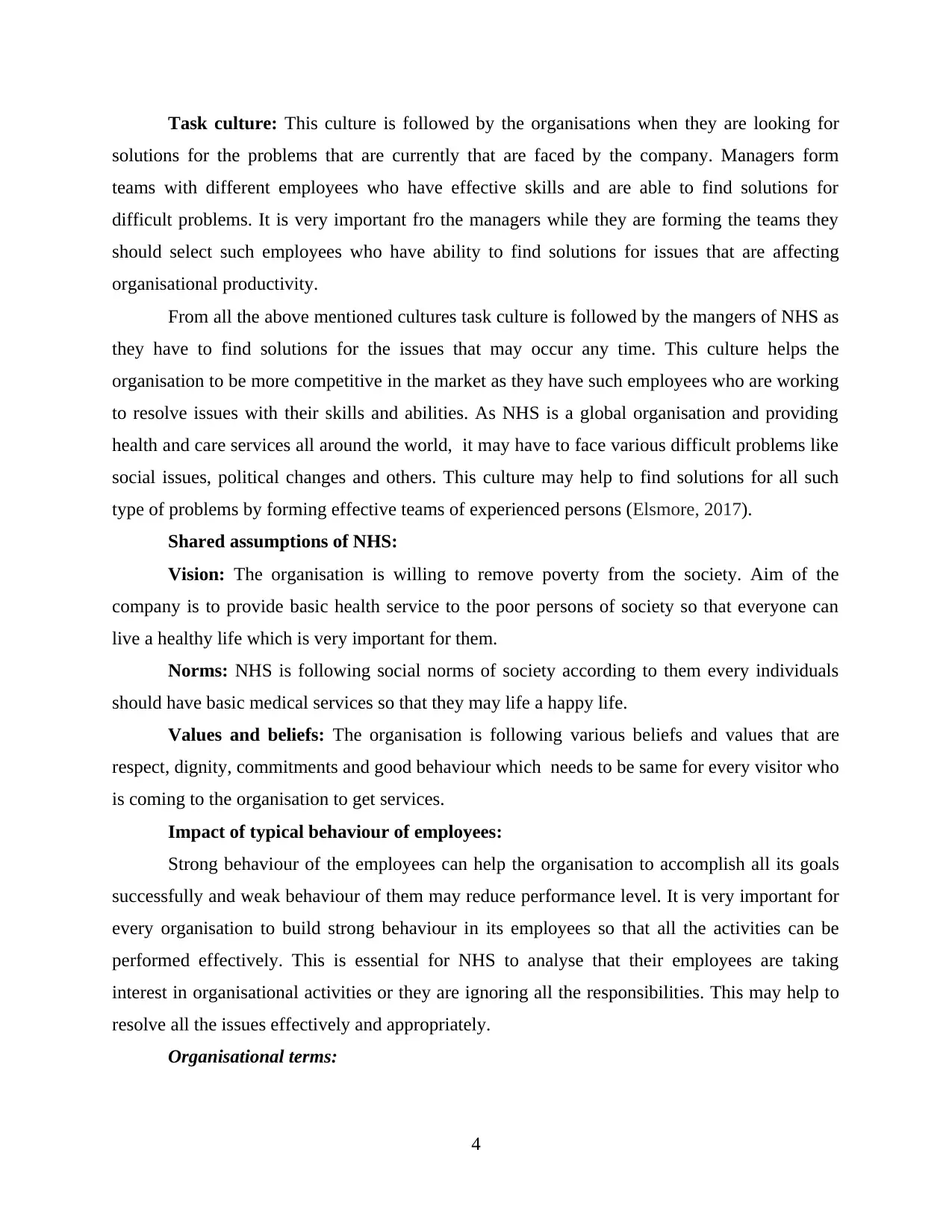
Task culture: This culture is followed by the organisations when they are looking for
solutions for the problems that are currently that are faced by the company. Managers form
teams with different employees who have effective skills and are able to find solutions for
difficult problems. It is very important fro the managers while they are forming the teams they
should select such employees who have ability to find solutions for issues that are affecting
organisational productivity.
From all the above mentioned cultures task culture is followed by the mangers of NHS as
they have to find solutions for the issues that may occur any time. This culture helps the
organisation to be more competitive in the market as they have such employees who are working
to resolve issues with their skills and abilities. As NHS is a global organisation and providing
health and care services all around the world, it may have to face various difficult problems like
social issues, political changes and others. This culture may help to find solutions for all such
type of problems by forming effective teams of experienced persons (Elsmore, 2017).
Shared assumptions of NHS:
Vision: The organisation is willing to remove poverty from the society. Aim of the
company is to provide basic health service to the poor persons of society so that everyone can
live a healthy life which is very important for them.
Norms: NHS is following social norms of society according to them every individuals
should have basic medical services so that they may life a happy life.
Values and beliefs: The organisation is following various beliefs and values that are
respect, dignity, commitments and good behaviour which needs to be same for every visitor who
is coming to the organisation to get services.
Impact of typical behaviour of employees:
Strong behaviour of the employees can help the organisation to accomplish all its goals
successfully and weak behaviour of them may reduce performance level. It is very important for
every organisation to build strong behaviour in its employees so that all the activities can be
performed effectively. This is essential for NHS to analyse that their employees are taking
interest in organisational activities or they are ignoring all the responsibilities. This may help to
resolve all the issues effectively and appropriately.
Organisational terms:
4
solutions for the problems that are currently that are faced by the company. Managers form
teams with different employees who have effective skills and are able to find solutions for
difficult problems. It is very important fro the managers while they are forming the teams they
should select such employees who have ability to find solutions for issues that are affecting
organisational productivity.
From all the above mentioned cultures task culture is followed by the mangers of NHS as
they have to find solutions for the issues that may occur any time. This culture helps the
organisation to be more competitive in the market as they have such employees who are working
to resolve issues with their skills and abilities. As NHS is a global organisation and providing
health and care services all around the world, it may have to face various difficult problems like
social issues, political changes and others. This culture may help to find solutions for all such
type of problems by forming effective teams of experienced persons (Elsmore, 2017).
Shared assumptions of NHS:
Vision: The organisation is willing to remove poverty from the society. Aim of the
company is to provide basic health service to the poor persons of society so that everyone can
live a healthy life which is very important for them.
Norms: NHS is following social norms of society according to them every individuals
should have basic medical services so that they may life a happy life.
Values and beliefs: The organisation is following various beliefs and values that are
respect, dignity, commitments and good behaviour which needs to be same for every visitor who
is coming to the organisation to get services.
Impact of typical behaviour of employees:
Strong behaviour of the employees can help the organisation to accomplish all its goals
successfully and weak behaviour of them may reduce performance level. It is very important for
every organisation to build strong behaviour in its employees so that all the activities can be
performed effectively. This is essential for NHS to analyse that their employees are taking
interest in organisational activities or they are ignoring all the responsibilities. This may help to
resolve all the issues effectively and appropriately.
Organisational terms:
4
⊘ This is a preview!⊘
Do you want full access?
Subscribe today to unlock all pages.

Trusted by 1+ million students worldwide

Span of control: It is mainly used in human resource management in which all the
employees are controlled by higher authority of the company. In NHS all the employees and
health care professionals are controlled and monitored by their supervisors.
Chain of command: In this function all the decisions are taken by higher authority of the
company and they supervise middle level manager. These managers give command to the lower
level managers. All the employees are controlled by the general or lower level mangers. In NHS
higher authority guide all the healthcare professionals and they guide the other employees who
are responsible to provide service to the patients (Crane, 2017).
Centralisation: In this function all the power is divided in the employees. In NHS all the
decisions are taken by the managers and they consider the opinion of the employees who are
working under them.
TASK 2
P3 Impact and role of central and local government in the public services
Central and local government are the authorities which control and monitor all the affairs
in their jurisdiction. There are various kinds of central and local authorities such as Police
complaints body, Ministry of finance, Ministry of Justice, Ministry of Defence and Inspectorate
of Constabulary. National health services is a government body which works as a public
company. Impact of these central and local governmental body are mentioned below:
Budget – Budget is the future plan for expenses. Central government prepares budget for
health care services in order to provide them funds and grants by which they can carry their
activities. Preparing a budget for National health services is a role of central government (Chang,
2015).
Spending review – In this role, local government conducts a monthly review to the
activities of public companies which are engaged in providing public services such as NHS
which provides health services to society. This role also includes investigation and monitoring
adherence of operations of company.
Funding – This is the most important role of Central governmental authorities such as
Ministry of finance. This authority provides funds to public companies in order to conduct their
operations more effectively. For example: National health services procures funds from Ministry
of finance by providing them their expenses records.
5
employees are controlled by higher authority of the company. In NHS all the employees and
health care professionals are controlled and monitored by their supervisors.
Chain of command: In this function all the decisions are taken by higher authority of the
company and they supervise middle level manager. These managers give command to the lower
level managers. All the employees are controlled by the general or lower level mangers. In NHS
higher authority guide all the healthcare professionals and they guide the other employees who
are responsible to provide service to the patients (Crane, 2017).
Centralisation: In this function all the power is divided in the employees. In NHS all the
decisions are taken by the managers and they consider the opinion of the employees who are
working under them.
TASK 2
P3 Impact and role of central and local government in the public services
Central and local government are the authorities which control and monitor all the affairs
in their jurisdiction. There are various kinds of central and local authorities such as Police
complaints body, Ministry of finance, Ministry of Justice, Ministry of Defence and Inspectorate
of Constabulary. National health services is a government body which works as a public
company. Impact of these central and local governmental body are mentioned below:
Budget – Budget is the future plan for expenses. Central government prepares budget for
health care services in order to provide them funds and grants by which they can carry their
activities. Preparing a budget for National health services is a role of central government (Chang,
2015).
Spending review – In this role, local government conducts a monthly review to the
activities of public companies which are engaged in providing public services such as NHS
which provides health services to society. This role also includes investigation and monitoring
adherence of operations of company.
Funding – This is the most important role of Central governmental authorities such as
Ministry of finance. This authority provides funds to public companies in order to conduct their
operations more effectively. For example: National health services procures funds from Ministry
of finance by providing them their expenses records.
5
Paraphrase This Document
Need a fresh take? Get an instant paraphrase of this document with our AI Paraphraser
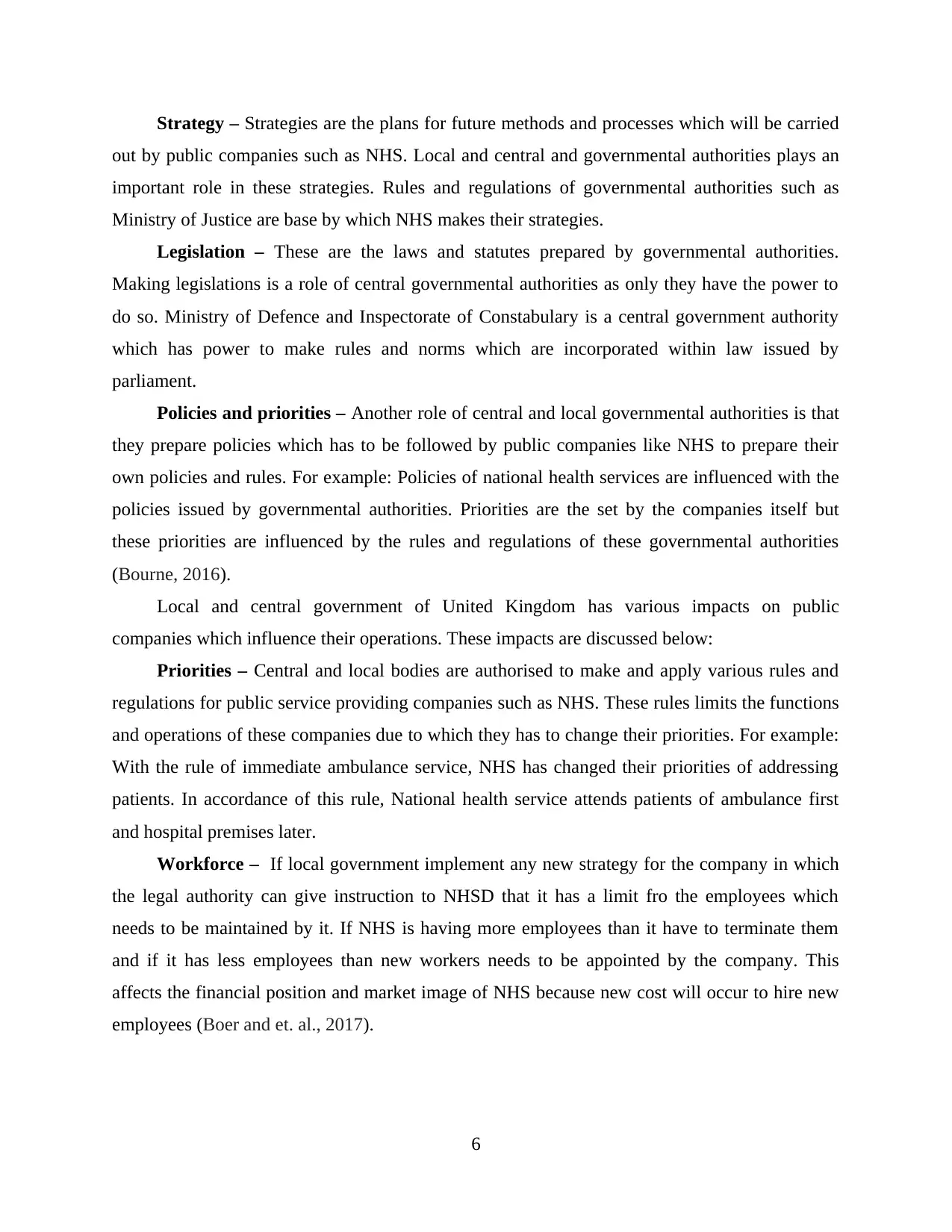
Strategy – Strategies are the plans for future methods and processes which will be carried
out by public companies such as NHS. Local and central and governmental authorities plays an
important role in these strategies. Rules and regulations of governmental authorities such as
Ministry of Justice are base by which NHS makes their strategies.
Legislation – These are the laws and statutes prepared by governmental authorities.
Making legislations is a role of central governmental authorities as only they have the power to
do so. Ministry of Defence and Inspectorate of Constabulary is a central government authority
which has power to make rules and norms which are incorporated within law issued by
parliament.
Policies and priorities – Another role of central and local governmental authorities is that
they prepare policies which has to be followed by public companies like NHS to prepare their
own policies and rules. For example: Policies of national health services are influenced with the
policies issued by governmental authorities. Priorities are the set by the companies itself but
these priorities are influenced by the rules and regulations of these governmental authorities
(Bourne, 2016).
Local and central government of United Kingdom has various impacts on public
companies which influence their operations. These impacts are discussed below:
Priorities – Central and local bodies are authorised to make and apply various rules and
regulations for public service providing companies such as NHS. These rules limits the functions
and operations of these companies due to which they has to change their priorities. For example:
With the rule of immediate ambulance service, NHS has changed their priorities of addressing
patients. In accordance of this rule, National health service attends patients of ambulance first
and hospital premises later.
Workforce – If local government implement any new strategy for the company in which
the legal authority can give instruction to NHSD that it has a limit fro the employees which
needs to be maintained by it. If NHS is having more employees than it have to terminate them
and if it has less employees than new workers needs to be appointed by the company. This
affects the financial position and market image of NHS because new cost will occur to hire new
employees (Boer and et. al., 2017).
6
out by public companies such as NHS. Local and central and governmental authorities plays an
important role in these strategies. Rules and regulations of governmental authorities such as
Ministry of Justice are base by which NHS makes their strategies.
Legislation – These are the laws and statutes prepared by governmental authorities.
Making legislations is a role of central governmental authorities as only they have the power to
do so. Ministry of Defence and Inspectorate of Constabulary is a central government authority
which has power to make rules and norms which are incorporated within law issued by
parliament.
Policies and priorities – Another role of central and local governmental authorities is that
they prepare policies which has to be followed by public companies like NHS to prepare their
own policies and rules. For example: Policies of national health services are influenced with the
policies issued by governmental authorities. Priorities are the set by the companies itself but
these priorities are influenced by the rules and regulations of these governmental authorities
(Bourne, 2016).
Local and central government of United Kingdom has various impacts on public
companies which influence their operations. These impacts are discussed below:
Priorities – Central and local bodies are authorised to make and apply various rules and
regulations for public service providing companies such as NHS. These rules limits the functions
and operations of these companies due to which they has to change their priorities. For example:
With the rule of immediate ambulance service, NHS has changed their priorities of addressing
patients. In accordance of this rule, National health service attends patients of ambulance first
and hospital premises later.
Workforce – If local government implement any new strategy for the company in which
the legal authority can give instruction to NHSD that it has a limit fro the employees which
needs to be maintained by it. If NHS is having more employees than it have to terminate them
and if it has less employees than new workers needs to be appointed by the company. This
affects the financial position and market image of NHS because new cost will occur to hire new
employees (Boer and et. al., 2017).
6
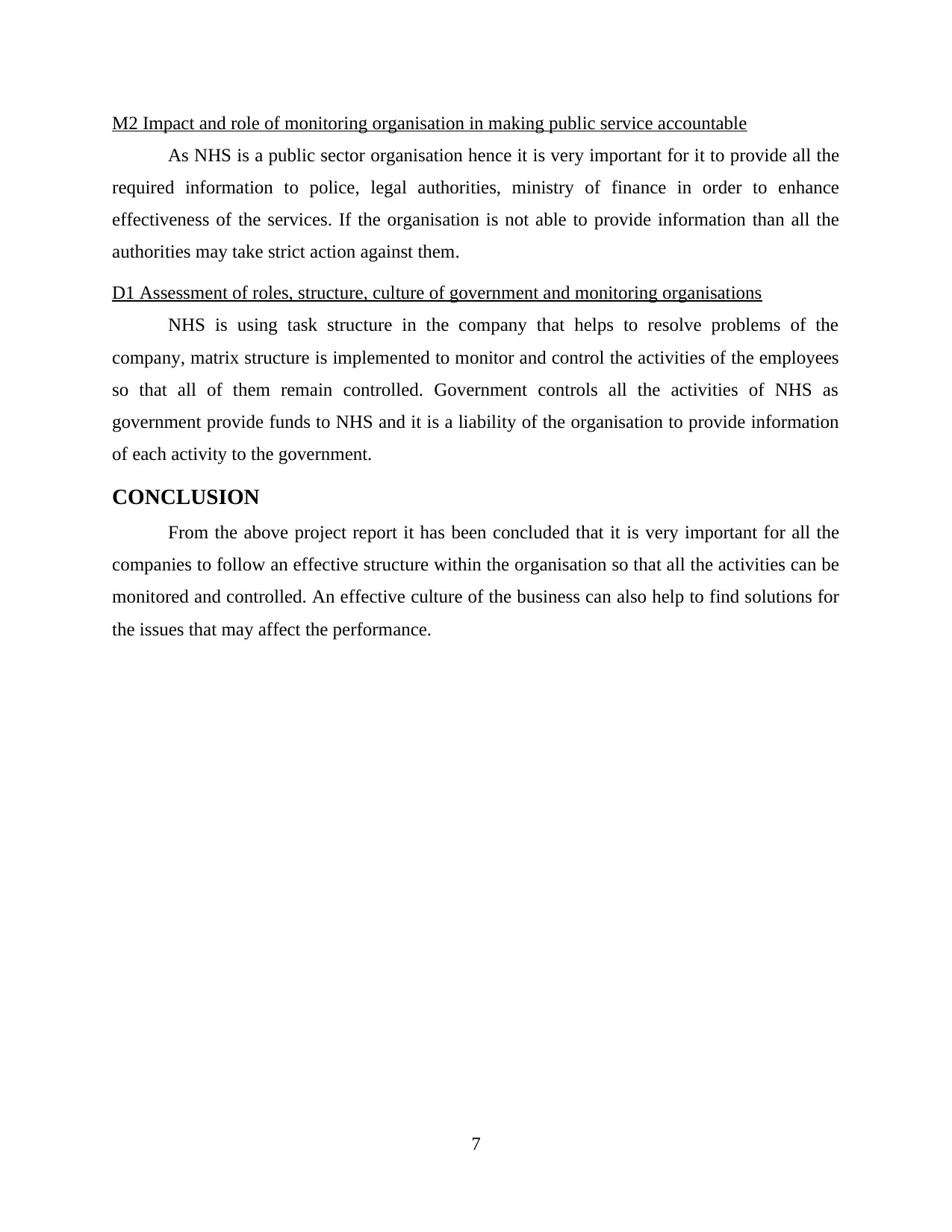
M2 Impact and role of monitoring organisation in making public service accountable
As NHS is a public sector organisation hence it is very important for it to provide all the
required information to police, legal authorities, ministry of finance in order to enhance
effectiveness of the services. If the organisation is not able to provide information than all the
authorities may take strict action against them.
D1 Assessment of roles, structure, culture of government and monitoring organisations
NHS is using task structure in the company that helps to resolve problems of the
company, matrix structure is implemented to monitor and control the activities of the employees
so that all of them remain controlled. Government controls all the activities of NHS as
government provide funds to NHS and it is a liability of the organisation to provide information
of each activity to the government.
CONCLUSION
From the above project report it has been concluded that it is very important for all the
companies to follow an effective structure within the organisation so that all the activities can be
monitored and controlled. An effective culture of the business can also help to find solutions for
the issues that may affect the performance.
7
As NHS is a public sector organisation hence it is very important for it to provide all the
required information to police, legal authorities, ministry of finance in order to enhance
effectiveness of the services. If the organisation is not able to provide information than all the
authorities may take strict action against them.
D1 Assessment of roles, structure, culture of government and monitoring organisations
NHS is using task structure in the company that helps to resolve problems of the
company, matrix structure is implemented to monitor and control the activities of the employees
so that all of them remain controlled. Government controls all the activities of NHS as
government provide funds to NHS and it is a liability of the organisation to provide information
of each activity to the government.
CONCLUSION
From the above project report it has been concluded that it is very important for all the
companies to follow an effective structure within the organisation so that all the activities can be
monitored and controlled. An effective culture of the business can also help to find solutions for
the issues that may affect the performance.
7
⊘ This is a preview!⊘
Do you want full access?
Subscribe today to unlock all pages.

Trusted by 1+ million students worldwide
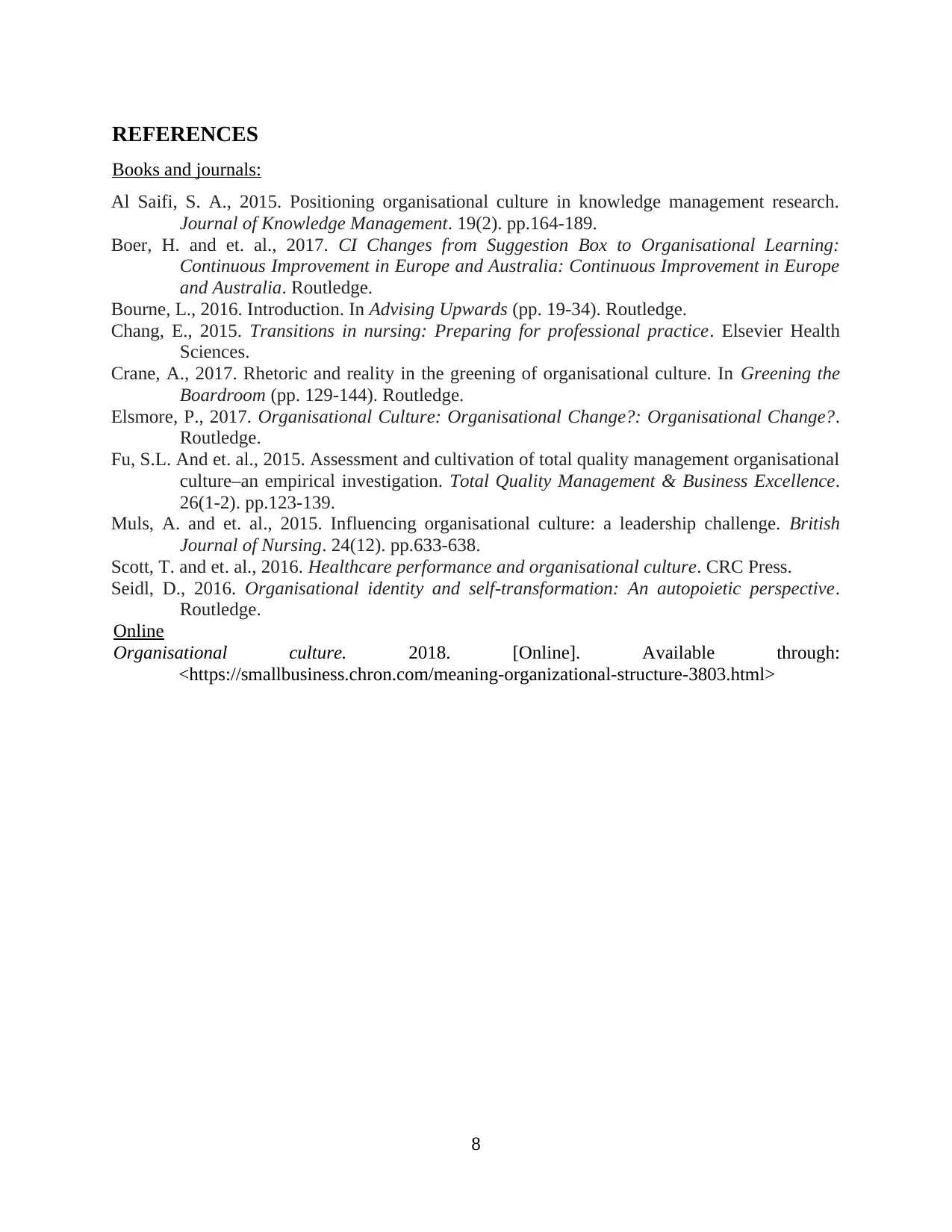
REFERENCES
Books and journals:
Al Saifi, S. A., 2015. Positioning organisational culture in knowledge management research.
Journal of Knowledge Management. 19(2). pp.164-189.
Boer, H. and et. al., 2017. CI Changes from Suggestion Box to Organisational Learning:
Continuous Improvement in Europe and Australia: Continuous Improvement in Europe
and Australia. Routledge.
Bourne, L., 2016. Introduction. In Advising Upwards (pp. 19-34). Routledge.
Chang, E., 2015. Transitions in nursing: Preparing for professional practice. Elsevier Health
Sciences.
Crane, A., 2017. Rhetoric and reality in the greening of organisational culture. In Greening the
Boardroom (pp. 129-144). Routledge.
Elsmore, P., 2017. Organisational Culture: Organisational Change?: Organisational Change?.
Routledge.
Fu, S.L. And et. al., 2015. Assessment and cultivation of total quality management organisational
culture–an empirical investigation. Total Quality Management & Business Excellence.
26(1-2). pp.123-139.
Muls, A. and et. al., 2015. Influencing organisational culture: a leadership challenge. British
Journal of Nursing. 24(12). pp.633-638.
Scott, T. and et. al., 2016. Healthcare performance and organisational culture. CRC Press.
Seidl, D., 2016. Organisational identity and self-transformation: An autopoietic perspective.
Routledge.
Online
Organisational culture. 2018. [Online]. Available through:
<https://smallbusiness.chron.com/meaning-organizational-structure-3803.html>
8
Books and journals:
Al Saifi, S. A., 2015. Positioning organisational culture in knowledge management research.
Journal of Knowledge Management. 19(2). pp.164-189.
Boer, H. and et. al., 2017. CI Changes from Suggestion Box to Organisational Learning:
Continuous Improvement in Europe and Australia: Continuous Improvement in Europe
and Australia. Routledge.
Bourne, L., 2016. Introduction. In Advising Upwards (pp. 19-34). Routledge.
Chang, E., 2015. Transitions in nursing: Preparing for professional practice. Elsevier Health
Sciences.
Crane, A., 2017. Rhetoric and reality in the greening of organisational culture. In Greening the
Boardroom (pp. 129-144). Routledge.
Elsmore, P., 2017. Organisational Culture: Organisational Change?: Organisational Change?.
Routledge.
Fu, S.L. And et. al., 2015. Assessment and cultivation of total quality management organisational
culture–an empirical investigation. Total Quality Management & Business Excellence.
26(1-2). pp.123-139.
Muls, A. and et. al., 2015. Influencing organisational culture: a leadership challenge. British
Journal of Nursing. 24(12). pp.633-638.
Scott, T. and et. al., 2016. Healthcare performance and organisational culture. CRC Press.
Seidl, D., 2016. Organisational identity and self-transformation: An autopoietic perspective.
Routledge.
Online
Organisational culture. 2018. [Online]. Available through:
<https://smallbusiness.chron.com/meaning-organizational-structure-3803.html>
8
1 out of 10
Related Documents
Your All-in-One AI-Powered Toolkit for Academic Success.
+13062052269
info@desklib.com
Available 24*7 on WhatsApp / Email
![[object Object]](/_next/static/media/star-bottom.7253800d.svg)
Unlock your academic potential
© 2024 | Zucol Services PVT LTD | All rights reserved.





